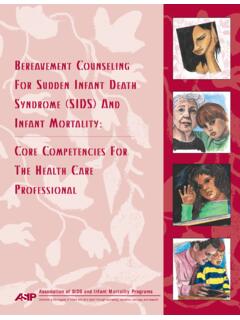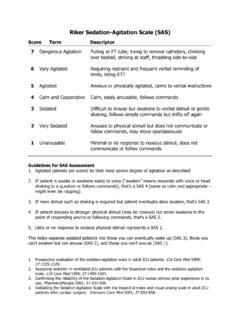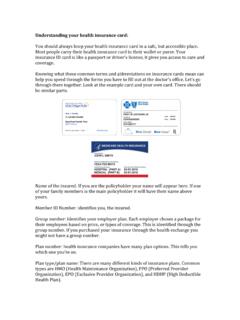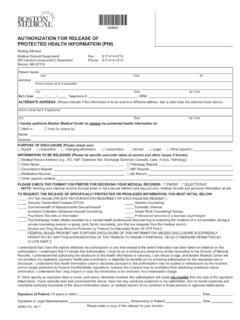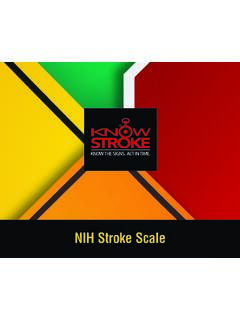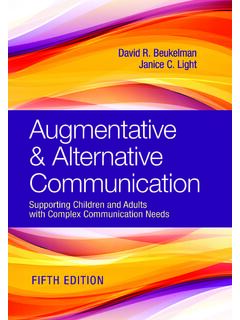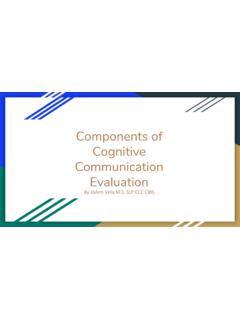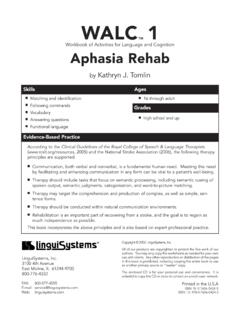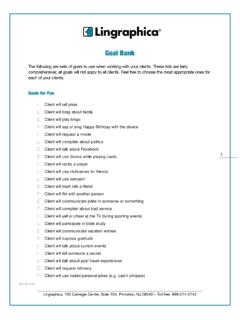Transcription of NIH Stroke Scale - Boston Medical Center
1 (Continued) NIH Stroke Scale Instructions Scale Definition Score 1a. Level of consciousness: The investigator must choosresponse, even if a full evaluation is prevented by such obstacles as an endotracheal tube,e a language barrier, orotracheal trauma/bandages. A "3" is scored only if the patient makes no movement (other than reflexive posturing) in response to noxious stimulation. mulation o make 3 = Responds only with reflex motor or _____ 0 = Alert; keenly responsive 1 = Not alert, but arousable by minor stimulation to obey, answer, or respond 2 = Not alert, requires repeated sti to attend, or is obtunded and requires strong or painful stimulation t movements (not stereotyped) autonomic effects or totally unresponsive, flaccid, areflexic 1b. LOC Questions: The patient is asked the month and his/her age.
2 The answer must be correct - there is no partcredit for being close. Aphasic and stuporous patients who donot comprehend the questions will score "2." Patients unable to speak because of endotracheal intubation, orotracheal trauma, severe dysarthia from any cause, language barrier orany other problem ial not secondary to aphasia are given a "1." It is important that only the initial answer be graded and = Answers both questions correctly 1 = Answers one question correctly 2 = Answers neither question correctly _____ that the examiner not "help" the patient with verbal or non-verbal cues. 0 1c. LOC Commands: The patient is asked to open and closthe eyes and then to grip and release the non-paretic handSubstitute another one-step command if the hands cannot be used. Credit is given if an unequivocal attempt is made but not completed due to weakness.
3 If the patient does not respond to commands, the task should be demonstrated to them (pantomime) and score the result ( , follows none,e . one or two commands). Patients with trauma, amputation, or = Performs both tasks correctly 1 = Performs one task correctly 2 = Performs neither task correctly _____ other physical impediments should be given suitable one-step commands. Only the first attempt is scored. 0 2. Best Gaze: Only horizontal eye movements will be teVoluntary or reflexive (oculocephalic) eye movements wiscored but calorie testing is not done. If the patient has a conjugate deviation of the eyes that can be overcome by voluntary or reflexive activity, the score will be "1." If a patient has an isolated peripheral nerve paresis (CN, III, IV orVI) score a "1." Gaze is testable in all aphasic patientPatients with ocular trauma, bandages, pre-existing blindness or other disorder of visual acuity or fields should be testedwith reflexive movements and a choice sted.
4 Ll be s. made by the investigator. Establishing eyes contact and then moving about ven when gaze is abnormal in one or both 2 = Forced deviation, or total gaze paresis not overcome by the oculocephalic maneuver _____ the patient from side to side will occasionally clarify the presence of a partial gaze palsy. 0 = Normal 1 = Partial gaze palsy. This score is gi eyes, but where forced deviation or total gaze paresis are not present 3. Visual: Visual fields (upper and lower quadrants) are tested by confrontation, using finger counting or visual thras appropriate. Patient must be encouraged, but if they look at the side of the moving fingers appropriately, this can be scored as normal. If there is unilateral blindness or enucleavisual fields in the remaining eye are scored. Score 1 only if a clear-cut asymmetry, including quadrant anopia is found.
5 If patient is blind from any ceat tion, ause, score "3." Double simultaneous stimulation is performed at this point. If there is extinction, patient receives a "1" and the results are used to answer question #11. = No visual loss = Partial hemianopia mianopia 3 = Bilateral hemianopia (blind, including cortical blindness) _____ 0 1 2 = Complete heNIH Stroke Scale - Continued (Continued) 4. Facial Palsy: Ask, or use pantomime to encourage the patient to show teeth or raise eyebrows and close eyes. Score symmetry of grimace in response to noxious stimuli in the poorly responsive or non-comprehending patient. If facial trauma/bandages, orotracheal tube, tape or other physical barrier obscures the face, these should be removed to the extent possible. 0 = Normal symmetrical movement 1 = Minor paralysis (flattened nasolabial fold, asymmetry on smiling) 2 = Partial paralysis (total or near total paralysis of lower face) 3 = Complete paralysis of one or both sides (absence of facial movement in the upper and lower face) _____ 0 = No drift, limb holds 90 (or 45) degrees for full 10 seconds 1 = Drift, Limb holds 90 (or 45) degrees, but drifts down before full 10 seconds; does not hit bed or other support 2 = Some effort against gravity, limb cannot get to or maintain (if cued) 90 (or 45) degrees, drifts down to bed, but has some effort against gravity 3 = No effort against gravity, limb falls 4 = No movement 9 = Amputation, joint fusion explain:_____ 5a.
6 Left 5b. Right _____ _____ 5 & 6. Motor Arm and Leg: The limb is placed in the appropriate position: extend the arms (palms down) 90 degrees (if sitting) or 45 degrees (if supine) and the leg 30 degrees (always tested supine). Drift is scored if the arm falls before 10 seconds or the leg before 5 seconds. The aphasic patient is encouraged using urgency in the voice and pantomime but not noxious stimulation. Each limb is tested in turn, beginning with the non-paretic arm. Only in the case of amputation or joint fusion at the shoulder or hip may the score be "9" and the examiner must clearly write the explanation for scoring as a "9". 0 = No drift, leg holds 30 degrees position for full 5 seconds. 1 = Drift, leg falls by the end of the 5 second period but does not hit bed. 2 = Some effort against gravity; leg falls to bed by 5 seconds, but has some effort against gravity.
7 3 = No effort against gravity, leg falls to bed immediately. 4 = No movement 9 = Amputation, joint fusion explain:_____ 6a. Left 6b. Right _____ _____ 7. Limb Ataxia: This item is aimed at finding evidence of a unilateral cerebellar lesion. Test with eyes open. In case of visual defect, insure testing is done in intact visual field. The finger-nose-finger and heel-shin tests are performed on both sides, and ataxia is scored only if present out of proportion to weakness. Ataxia is absent in the patient who cannot understand or is paralyzed. Only in the case of amputation or joint fusion may the item be scored "9", and the examiner must clearly write the explanation for not scoring. In case of blindness test by touching nose from extended arm position. 0 = Absent 1 = Present in one limb 2 = Present in two limbs _____ 8.
8 Sensory: Sensation or grimace to pin prick when tested, or withdrawal from noxious stimulus in the obtunded or aphasic patient. Only sensory loss attributed to Stroke is scored as abnormal and the examiner should test as many body areas [arms (not hands), legs, trunk, face] as needed to accurately check for hemisensory loss. A score of 2, "severe or total," should only be given when a severe or total loss of sensation can be clearly demonstrated. Stuporous and aphasic patients will therefore probably score 1 or 0. The patient with brain stem Stroke who has bilateral loss of sensation is scored 2. If the patient does not respond and is quadriplegic score 2. Patients in coma (item 1a=3) are arbitrarily given a 2 on this item. 0 = Normal; no sensory loss 1 = Mild to moderate sensory loss; patient feels pinprick is less sharp or is dull on the affected s side; or there is a loss of superficial pain with pinprick but patient is aware he/she is being touched 2 = Severe to total sensory loss; patient is not aware of being touched in the face, arm and leg _____ NIH Stroke Scale - Continued 9.
9 Best Language: A great deal of information about comprehension will be obtained during the preceding sections of the examination. The patient is asked to describe what is happening in the attached picture, to name the items on the attached naming sheet, and to read from the attached list of sentences. Comprehension is judged from responses here as well as to all of the commands in the preceding general neurological exam. If visual loss interferes with the tests, ask the patient to identify objects placed in the hand, repeat, and produce speech. The intubated patient should be asked to write. The patient in coma (question 1a=3) will arbitrarily score 3 on this item. The examiner must choose a score in the patient with stupor or limited cooperation but a score of 3 should be used only if the patient is mute and follows no one step commands.
10 0 = No aphasia , normal 1 = Mild to moderate aphasia ; some obvious loss of fluency or facility of comprehension, without significant limitation on ideas expressed or form of expression. Reduction of speech and/or comprehension, however, makes conversation about provided material difficult or impossible. For example in conversation about provided materials examiner can identify picture or naming card from patient s response. 2 = Severe aphasia ; all communication is through fragmentary expression; great need for inference, questioning and guessing by the listener. Range of information that can be exchanged is limited; listener carries burden of communication. Examiner cannot identify materials provided from patient response. 3 = Mute, global aphasia ; no usable speech or auditory comprehension _____ 10.

